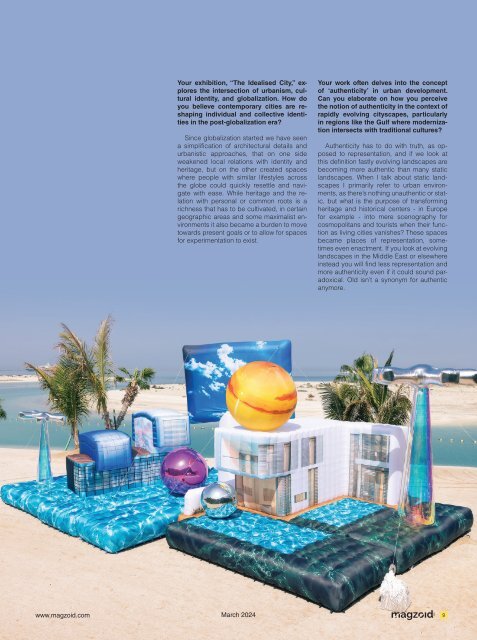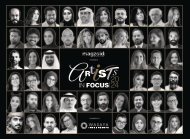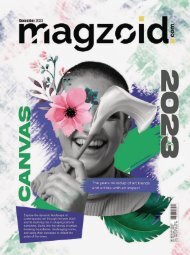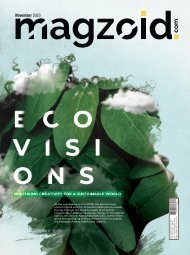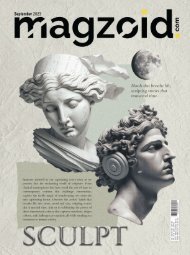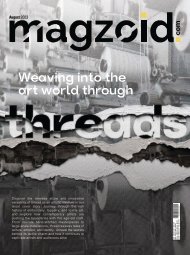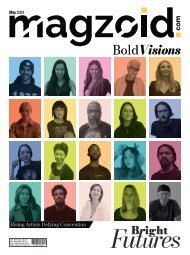Magzoid Magazine - Luxury Magazine in the Creative Space | March 2024 |
“Calligraphy is the most intimate, private, and spontaneous expressive means. Like a fingerprint or voice, it is unique with every person.” ― Hermann Zapf Welcome to the March edition of Magzoid Magazine, where creativity takes center stage in our special collaboration with Brands for Less and artist Advay Sureka. Our cover story celebrates the limitless possibilities of creativity with a unique partnership, promising an exploration of innovation and imagination. In our exclusive interview, artist Filippo Minelli unveils the intricate relationship between urbanism, cultural identity, and globalization through his exhibition, "The Idealised City." As the month begins, we also mark the beginning of Ramadan, a time of spiritual reflection and community.
“Calligraphy is the most intimate, private, and spontaneous expressive means. Like a fingerprint or voice, it is unique with every person.”
― Hermann Zapf
Welcome to the March edition of Magzoid Magazine, where creativity takes center stage in our special collaboration with Brands for Less and artist Advay Sureka.
Our cover story celebrates the limitless possibilities of creativity with a unique partnership, promising an exploration of innovation and imagination.
In our exclusive interview, artist Filippo Minelli unveils the intricate relationship between urbanism, cultural identity, and globalization through his exhibition, "The Idealised City."
As the month begins, we also mark the beginning of Ramadan, a time of spiritual reflection and community.
Create successful ePaper yourself
Turn your PDF publications into a flip-book with our unique Google optimized e-Paper software.
Your exhibition, “The Idealised City,” explores<br />
<strong>the</strong> <strong>in</strong>tersection of urbanism, cultural<br />
identity, and globalization. How do<br />
you believe contemporary cities are reshap<strong>in</strong>g<br />
<strong>in</strong>dividual and collective identities<br />
<strong>in</strong> <strong>the</strong> post-globalization era?<br />
S<strong>in</strong>ce globalization started we have seen<br />
a simplification of architectural details and<br />
urbanistic approaches, that on one side<br />
weakened local relations with identity and<br />
heritage, but on <strong>the</strong> o<strong>the</strong>r created spaces<br />
where people with similar lifestyles across<br />
<strong>the</strong> globe could quickly resettle and navigate<br />
with ease. While heritage and <strong>the</strong> relation<br />
with personal or common roots is a<br />
richness that has to be cultivated, <strong>in</strong> certa<strong>in</strong><br />
geographic areas and some maximalist environments<br />
it also became a burden to move<br />
towards present goals or to allow for spaces<br />
for experimentation to exist.<br />
Your work often delves <strong>in</strong>to <strong>the</strong> concept<br />
of ‘au<strong>the</strong>nticity’ <strong>in</strong> urban development.<br />
Can you elaborate on how you perceive<br />
<strong>the</strong> notion of au<strong>the</strong>nticity <strong>in</strong> <strong>the</strong> context of<br />
rapidly evolv<strong>in</strong>g cityscapes, particularly<br />
<strong>in</strong> regions like <strong>the</strong> Gulf where modernization<br />
<strong>in</strong>tersects with traditional cultures?<br />
Au<strong>the</strong>nticity has to do with truth, as opposed<br />
to representation, and if we look at<br />
this def<strong>in</strong>ition fastly evolv<strong>in</strong>g landscapes are<br />
becom<strong>in</strong>g more au<strong>the</strong>ntic than many static<br />
landscapes. When I talk about static landscapes<br />
I primarily refer to urban environments,<br />
as <strong>the</strong>re’s noth<strong>in</strong>g unau<strong>the</strong>ntic or static,<br />
but what is <strong>the</strong> purpose of transform<strong>in</strong>g<br />
heritage and historical centers - <strong>in</strong> Europe<br />
for example - <strong>in</strong>to mere scenography for<br />
cosmopolitans and tourists when <strong>the</strong>ir function<br />
as liv<strong>in</strong>g cities vanishes? These spaces<br />
became places of representation, sometimes<br />
even enactment. If you look at evolv<strong>in</strong>g<br />
landscapes <strong>in</strong> <strong>the</strong> Middle East or elsewhere<br />
<strong>in</strong>stead you will f<strong>in</strong>d less representation and<br />
more au<strong>the</strong>nticity even if it could sound paradoxical.<br />
Old isn’t a synonym for au<strong>the</strong>ntic<br />
anymore.<br />
www.magzoid.com <strong>March</strong> <strong>2024</strong><br />
9


